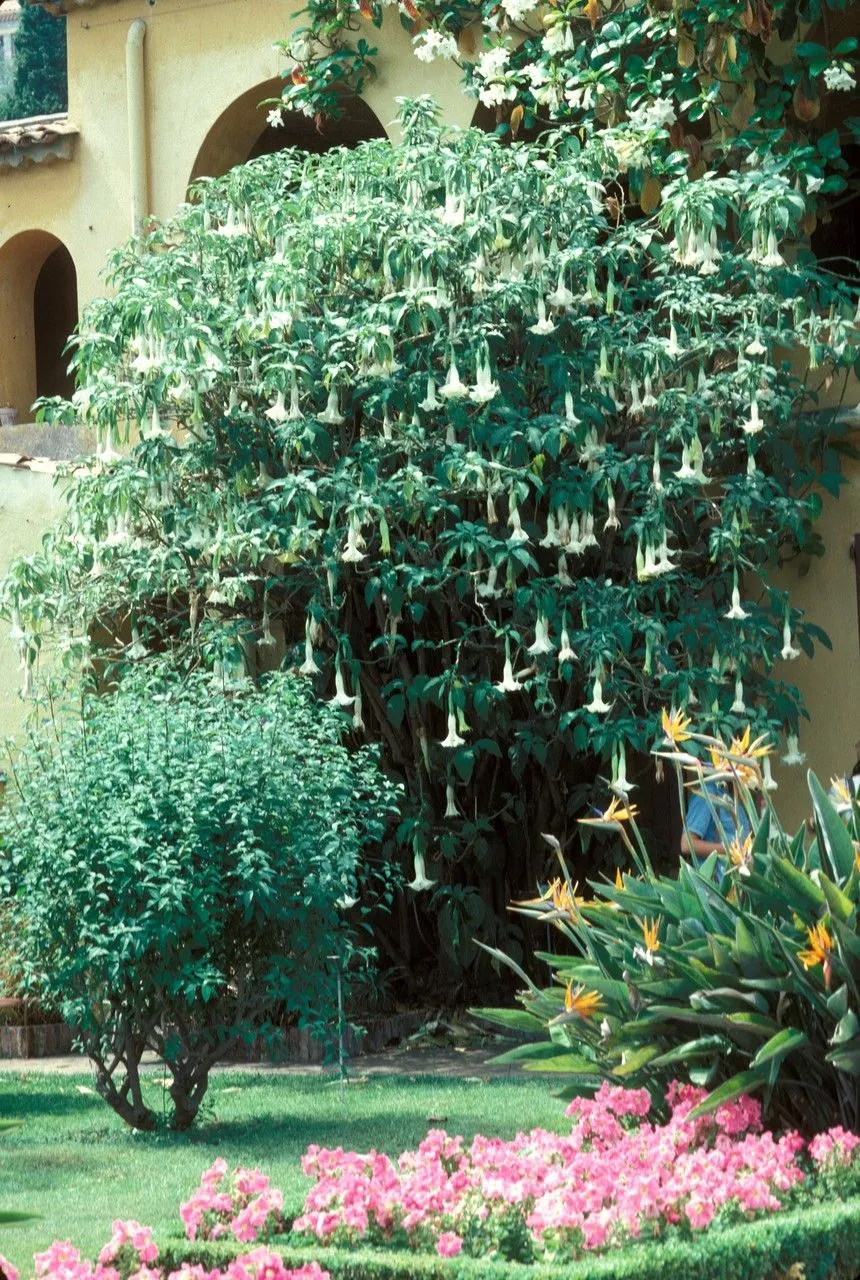
Author: (L.) Sweet
Bibliography: Hort. Suburb. Lond.: 41 (1818)
Year: 1818
Status: accepted
Rank: species
Genus: Brugmansia
Vegetable: False
Observations: Ecuador to N. Chile
The White Angel’s Trumpet, known scientifically as Brugmansia arborea, is a captivating species celebrated for its ethereal beauty and enchanting floral display. This remarkable plant belongs to the Solanaceae family and has intrigued botanists and horticulturists alike due to its distinctive characteristics and historical significance.
This magnificent plant was first described in 1818 by the renowned botanist (L.) Sweet in “Hort. Suburb. Lond.: 41”. Native to the diverse regions stretching from Ecuador to Northern Chile, Brugmansia arborea thrives in a variety of climates and elevations. Its adaptability and resilience in different environmental conditions underscore its significance in the flora of South America.
Brugmansia arborea is characterized by its large, trumpet-shaped flowers that elegantly dangle from its branches. These stunning white blooms, often tinged with a subtle green hue, emit a potent and intoxicating fragrance, particularly noticeable during the evening hours. The plant’s flowers not only captivate the eye but also play a critical role in attracting nocturnal pollinators, thus ensuring the continuation of its lineage.
Beyond its visual allure, White Angel’s Trumpet also holds cultural and traditional value in its native regions. Historically, various parts of the plant were utilized in traditional medicine and spiritual practices, although modern awareness stresses caution due to its toxic properties. All parts of the plant contain tropane alkaloids, which can be highly toxic if ingested, underscoring the importance of careful handling and respect for this botanical wonder.
The foliage of Brugmansia arborea further complements its overall aesthetic appeal. The broad, dark green leaves provide a striking contrast to the pale flowers, enhancing the plant’s ornamental value and making it a popular choice for gardens and landscape designs. However, due to its toxicity, it’s essential to plant it in areas where children and pets are unlikely to come into contact with it.
In summary, the White Angel’s Trumpet is not merely a plant; it is a symbol of natural elegance and resilience. Its enchanting flowers, rich fragrance, and significant cultural heritage make it a fascinating subject for study and cultivation. While it boasts remarkable beauty, it also demands respect and caution due to its potent alkaloids, reminding us of the delicate balance between nature’s allure and its inherent dangers.
En: White angel’s trumpet, Angel’s-trumpet
Ar: كولونيا شجرية
Ca: Trompetes
Zh: 木本曼陀罗
Fi: Tuoksupasuuna
Lt: Aukštoji brugmansija
Fa: تاتوره معطر
Pt: Anágua-de-vénus
Qu: Lumucha wantuq
Es: Borrachero
Sv: Liten änglatrumpet
© copyright of the Board of Trustees of the Royal Botanic Gardens, Kew.
© copyright of the Board of Trustees of the Royal Botanic Gardens, Kew.
© copyright of the Board of Trustees of the Royal Botanic Gardens, Kew.
Taken Jan 3, 2020 by Diego Alex (cc-by-sa)
Taken Feb 28, 2020 by Diego Alex (cc-by-sa)
Taken Sep 17, 2021 by Dieter Albrecht (cc-by-sa)
Taken Dec 7, 2022 by francois tissot (cc-by-sa)
Taken Sep 20, 2020 by Geraldine Bouye (cc-by-sa)
Taken Jun 21, 2020 by SaRa abde (cc-by-sa)
Taken May 27, 2020 by Mateus Aleja (cc-by-sa)
Taken Sep 3, 2020 by Christopher Brenner (cc-by-sa)
Taken Jun 28, 2022 by Gabriel Ollivier (cc-by-sa)
Taken Jun 1, 1982 by Daniel Barthelemy (cc-by-nc)
Taken Dec 7, 2022 by francois tissot (cc-by-sa)
Taken Sep 17, 2021 by Dieter Albrecht (cc-by-sa)
Taken Aug 25, 2020 by Oana von Raven (cc-by-sa)
Taken Dec 7, 2022 by francois tissot (cc-by-sa)
Taken Dec 7, 2022 by francois tissot (cc-by-sa)
Taken Nov 6, 2020 by Malcangi Alessandro (cc-by-sa)
Taken Oct 6, 2020 by Beatrice (cc-by-sa)
Taken Jul 29, 2021 by Antonio Rodriguez (cc-by-sa)
Taken May 29, 2017 by Daniel Barthelemy (cc-by-nc)
Family: Myrtaceae Author: (F.Muell.) K.D.Hill & L.A.S.Johnson Bibliography: Telopea 6: 402 (1995) Year: 1995 Status:…
Family: Rubiaceae Author: Pierre ex A.Froehner Bibliography: Notizbl. Bot. Gart. Berlin-Dahlem 1: 237 (1897) Year:…
Family: Sapindaceae Author: Koidz. Bibliography: J. Coll. Sci. Imp. Univ. Tokyo 32(1): 38 (1911) Year:…
Family: Asteraceae Author: A.Gray Bibliography: Pacif. Railr. Rep.: 107 (1857) Year: 1857 Status: accepted Rank:…
Family: Fabaceae Author: Medik. Bibliography: Vorles. Churpfälz. Phys.-Ökon. Ges. 2: 398 (1787) Year: 1787 Status:…
Family: Aspleniaceae Author: (Cav.) Alston Bibliography: Bull. Misc. Inform. Kew 1932: 309 (1932) Year: 1932…